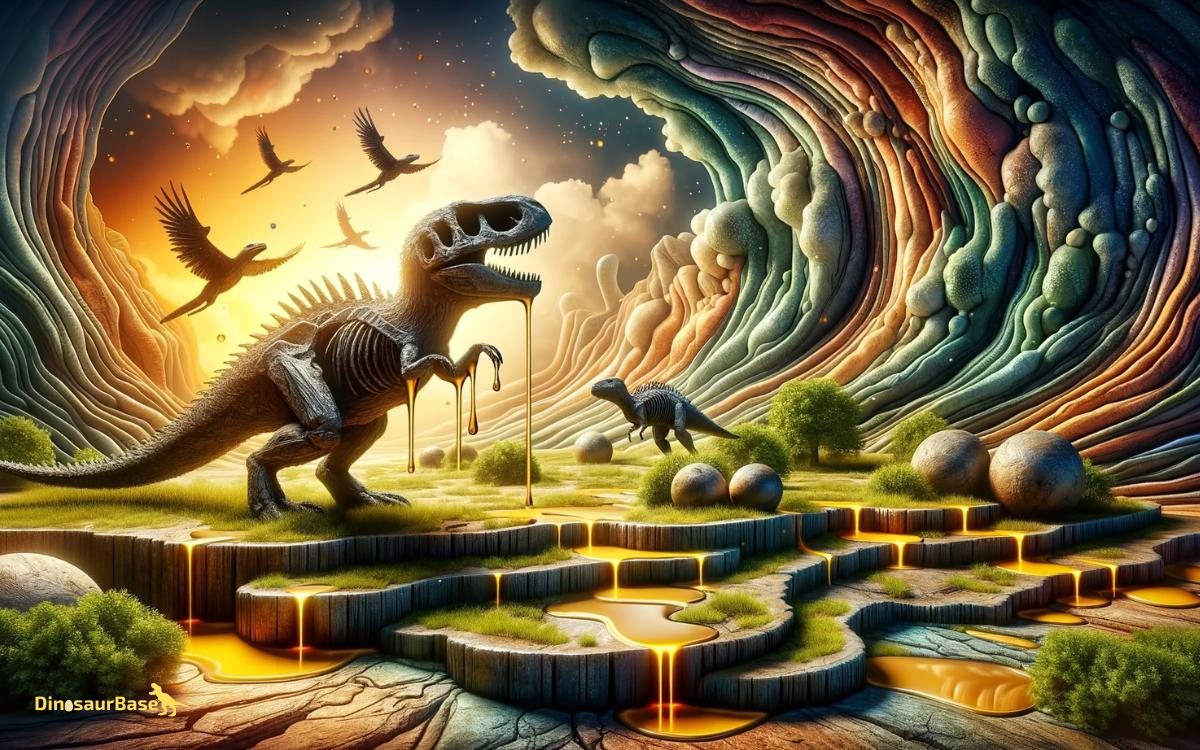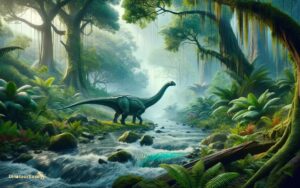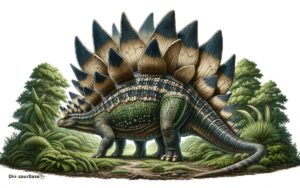Dinosaurs Are Marching: Unveiling the Secrets of Earth’s History!
Scientists often ponder if the titanic creatures of the Mesozoic era, the dinosaurs, truly exhibited the complex social behavior and migration patterns that current evidence suggests.
It’s a fascinating journey to trace how these behemoths, from the towering Brachiosaurus of the Jurassic to the fierce Tyrannosaurus of the Cretaceous, may have roamed the ancient landscapes in search of food, mates, or even as part of seasonal migrations.
While the clues lie scattered in the fossil records and amidst the layers of ancient sediment, they hint at a world where these giants not only ruled but thrived through intricate behaviors that challenge our understanding.
What secrets do these fossils hold, and how do they reshape our view of these majestic creatures’ lives? The answer might surprise you.


Key Takeaway
The Mesozoic Era Unveiled
Spanning approximately 186 million years, the Mesozoic Era represents a pivotal epoch in Earth’s geological and biological history, marked by the dominance and diversification of dinosaurs.
This era, subdivided into the Triassic, Jurassic, and Cretaceous periods, witnessed significant evolutionary, climatic, and geographical transformations.
The Triassic Period heralded the emergence of the earliest dinosaurs, following a mass extinction event that closed the preceding Paleozoic Era. The era’s climate varied from warm and dry to humid, fostering diverse ecosystems.
Flora evolved, with gymnosperms and later angiosperms dominating landscapes, providing varied diets for herbivorous dinosaurs.
The Mesozoic’s tectonic activity reshaped continents, influencing evolutionary pathways. These geological shifts, alongside climatic fluctuations, played crucial roles in the adaptive radiations that characterized the era, setting the stage for the dominance of dinosaurs.
Giants of the Jurassic Period
The Jurassic Period was a time of significant evolutionary advancements, marked by the emergence of behemoths that redefined terrestrial ecosystems.
This era witnessed a complex interplay between predators and prey, highlighting the intricate dynamics that governed survival.
Analyzing these relationships provides insight into the ecological frameworks that facilitated the dominance of these giant dinosaurs.
Jurassic Era Behemoths
Jurassic era behemoths, such as the Brachiosaurus, dominated the landscape with their sheer size and mass, representing a peak in dinosaur evolution. These giants showcased remarkable adaptations that allowed them to thrive.
- Physiological Adaptations: Their long necks enabled them to reach high vegetation, a crucial adaptation for survival in their ecosystems.
- Skeletal Strength: Their bone structure was uniquely designed to support massive bodies while minimizing energy expenditure during movement.
- Respiratory Efficiency: They possessed advanced respiratory systems, allowing for efficient oxygen intake, vital for their colossal size.
- Metabolic Regulation: These dinosaurs had a metabolism that could support their large size, balancing energy intake and expenditure effectively.
These characteristics not only highlight their dominance but also underscore the complexity of their existence in the Jurassic era.
Predators and Prey Dynamics
In the complex ecosystems of the Jurassic period, predator and prey dynamics played a critical role in shaping the evolutionary trajectory of these colossal beings. The interplay between the hunters and the hunted drove adaptations that are marveled at even today.
This relationship is not merely about survival but about the intricate balance that governed ancient ecosystems.
| Dinosaur | Role | Adaptation |
|---|---|---|
| Allosaurus | Predator | Sharp teeth, agility |
| Diplodocus | Prey | Long neck, size |
| Stegosaurus | Defense Prey | Spiked tail |
These dynamics underscore the importance of both physical adaptations and behavioral strategies. Predators developed remarkable hunting techniques, while prey species evolved defensive mechanisms and social behaviors to enhance their survival chances.
This interdependent relationship highlights the complexity of Jurassic ecosystems and the evolutionary arms race between predators and prey.
The Rise of Predators
As apex predators evolved, they fundamentally reshaped ecosystem dynamics during the Mesozoic era. The emergence of these dominant carnivores led to significant changes in the structure and function of terrestrial ecosystems.
This period witnessed a dramatic escalation in the arms race between predators and their prey, influencing evolutionary trajectories.
To better appreciate the complexity and significance of this era:
- Diversification: Predators diversified into numerous forms, adapting to various ecological niches.
- Specialization: Many developed specialized hunting strategies and physical adaptations.
- Ecological Impact: Their presence dictated the survival strategies of herbivorous dinosaurs.
- Evolutionary Pressure: Predators exerted selective pressure, propelling the evolution of defensive mechanisms among prey species.
Understanding the rise of these predators offers insights into the intricate balance of ancient ecosystems.
Behemoths of the Cretaceous
The Cretaceous period saw the emergence of titanic dinosaurs that dominated terrestrial ecosystems with unparalleled size and power. Among these behemoths, the Argentinosaurus stands out, estimated to reach lengths of up to 100 feet and weights that could surpass 100 tons.
This herbivorous giant exemplifies the peak of dinosaur gigantism, necessitating significant evolutionary adaptations in its skeletal structure and metabolic processes to support its massive size.
Similarly, the predator Spinosaurus, with its distinctive sail and aquatic adaptations, showcases the diverse evolutionary strategies that allowed these creatures to thrive in varied ecosystems.
Their existence underscores a period of intense competition for resources and space, driving the evolutionary innovation that characterizes the Cretaceous.
These giants’ lives and interactions provide invaluable insights into the dynamics of prehistoric ecosystems, reflecting a world of complexity and constant change.
Secrets in the Fossils
Unearthing dinosaur fossils has unlocked a treasure trove of information, revealing intricate details about their physiology, behaviors, and the environments in which they thrived.
These discoveries offer profound insights into the ancient world, enriching our understanding of these magnificent creatures.
- Bone Structure Analysis: Researchers deduce muscle mass and possible movement patterns, offering clues about how dinosaurs moved and interacted with their surroundings.
- Isotope Examination: Isotopes within the fossils indicate dinosaurs’ diets and the climates they lived in, providing a glimpse into ancient ecosystems.
- Feather Impressions: Fossils with feather impressions challenge our understanding of dinosaur evolution, suggesting a closer relationship with birds than previously believed.
- Nesting Behaviors: Fossilized nests and eggs reveal details about reproductive strategies and parental care among dinosaurs, shedding light on their social structures.
The Mystery of Extinction
While discoveries about dinosaur physiology and behavior have significantly expanded our knowledge, the reasons behind their sudden extinction remain a compelling enigma, inviting rigorous scientific investigation.
The prevailing hypothesis, supported by a wealth of geological and paleontological evidence, suggests a cataclysmic event, likely an asteroid impact, precipitated this mass extinction.
This theory posits that the resultant atmospheric alterations, including significant temperature drops and diminished sunlight, disrupted the dinosaurs’ food chains.
However, this explanation doesn’t fully account for the survival of other species, leading researchers to explore additional factors such as volcanic activity, climate change, and disease.
These multifaceted investigations underscore the complexity of the extinction event, highlighting the necessity for a nuanced understanding that considers multiple concurrent environmental stressors.
Dinosaur Behavior and Ecology
Delving into the rich tapestry of dinosaur behavior and ecology reveals intricate patterns of social interaction, feeding, and migration that once dominated ancient ecosystems.
Scholars have meticulously pieced together these patterns, drawing from fossil evidence and comparative anatomy with modern-day relatives.
This exploration brings to light:
- Social Structures: Evidence suggests some species exhibited complex social behaviors, including herd dynamics and possibly even forms of communication.
- Feeding Habits: Herbivores, carnivores, and omnivores had specialized diets that influenced their physical evolution and migration patterns.
- Reproductive Strategies: Nesting sites and fossilized eggs offer insights into the reproductive behaviors, nurturing practices, and the early life of dinosaurs.
- Ecological Roles: Dinosaurs occupied various ecological niches, impacting vegetation, prey-predator dynamics, and the overall health of their ecosystems.
Legacy of the Dinosaurs
The legacy of the dinosaurs, extending far beyond their extinction, continues to shape our understanding of biological evolution and ecological transformations.
Scientists now recognize dinosaurs as a cornerstone in the narrative of life on Earth, illustrating the dynamics of adaptation and survival over millions of years.
This profound impact isn’t only embedded in the fossil record but also influences modern ecological systems and the evolutionary trajectory of current species.
The avian descendants of theropod dinosaurs, for example, demonstrate how features developed for one purpose can find entirely new functions feathers for flight rather than temperature regulation.
Thus, the study of dinosaur evolution offers invaluable insights into the principles of natural selection and genetic drift, thereby enriching our comprehension of biodiversity and the resilience of life through the ages.
Conclusion
In the grand tapestry of Earth’s history, dinosaurs have left an indelible mark, painting a vivid picture of life’s resilience and diversity.
The Mesozoic Era, a crucible of evolution, witnessed the rise and fall of these magnificent creatures, whose bones whisper secrets of a world long past.
Analyzing their fossils, scientists unravel the mysteries of dinosaur behavior, ecology, and ultimately, their extinction, offering a poignant reminder of nature’s impermanence and the enduring legacy of the dinosaurs in the annals of time.





